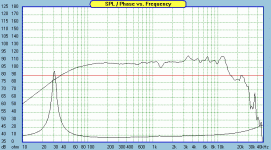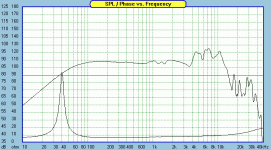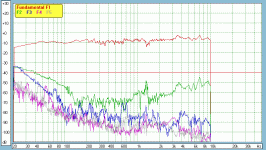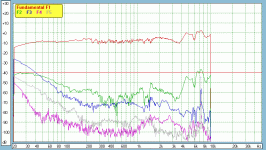Hi Joe
While your working on the hamlets, is there any chance that you could reduce the overall height and maybe add it to the length perhaps?
Not likely - and the boxes have already been made by spoonted.
When you measure the drivers in-situ before the computer modeling, changing the width or height and also the edge (like beveling) that changes the 'shape' of the front panel, will affect diffraction effects. The degree by which it changes can be unpredictable - so it if the size and shape of the front panel that gets captured and modeled correctly - change that and it hasn't been modeled. But if you decide to do as you suggest, then it may not make a huge difference, it is just that I cannot predict it.
Cheers, Joe
.
It is January 14th (Sydney time) and I never thought I would say this, but it now seems there will be a Mark 6 Elsinore after all. Both the Hamlets and Mark 6 Elsinores are slated for second half of February. The Hamlets will use the Nomex HDS driver and the Elsinores a new 6" driver, the Tweeter stays the same Peerless HDS/D2608/913000.
It is January 14th (Sydney time) and I never thought I would say this, but it now seems there will be a Mark 6 Elsinore after all. Both the Hamlets and Mark 6 Elsinores are slated for second half of February. The Hamlets will use the Nomex HDS driver and the Elsinores a new 6" driver, the Tweeter stays the same Peerless HDS/D2608/913000.
Hi Joe. Does this mean I have to lash out for 8 new drivers?
Hi Joe. Does this mean I have to lash out for 8 new drivers?How much improvement is to be gained?
On paper it should be an improvement - but the proof will be in the making of them. I mentioned this driver to a local guy who was about to start building Elsinores (he is only 10 minutes away) and I showed him this driver that I knew would also work, in fact, the measurements indicated the exact same box and tuning would work perfectly - so no changes there. And before I knew it, he sorta talked me in to it - and maybe something inside wanted to be talked into it.
As said - I have had the samples for a while and the idea has been percolating for some time, but it was not until the last few days - the fact that P. (I don't yet have permission to use his name) was offering to make the boxes and his close proximity - it means the boxes will be here and I can do the modelling.
The Crossover will be based on exactly what has been done in the Mark 5, but naturally values are going to be different. But hopefully not so different that your exist Crossover cannot be modified. Maybe the High-Pass to the HDS Tweeter may not need changing? But definitely the two series chokes will be different, and the choke going to the top two MidBass drivers will be much higher value, maybe from 0.3mH to as high as 1.5mH - the new driver has amazingly low inductance, near 1/3rd of the Nomex. This is definetely a plus and where I hope there will be a sonic advantage.
The driver:
SB Acoustics SB17NRXC35-8
Some may have realised that Dave Wilson's 6" Midrange Driver used right up to the 200 grand Alexandria XLF is roughly based on the driver. They will of course claim theirs is customised and improved - and yes, they don't measure exactly the same but the basic good stuff of this MidBass driver is still there.
The first design Wilson it was used in it was the MAXX 3 - take a read of this:
Product_maxx_drivers.shtml
"Wilson established a strategic partnership with a new driver... we created a unique blend of proprietary cellulose fibers."
Hmmm... it is actually Papyrus fibers - in fact a very high tech "long fiber" paper cone that was invented by Scan-Speak guys when they had their troubles with Tymphany - so take what Wilson says with a healthy grain of salt. But Scan-Speak guys have always said that they favour long fiber cones, and this continues that tradition. BTW, they are made in Indonesia by SB, which is a huge manufacturing and engineering company. And no criticising of Wilson either, as they have to do what they have to do.
P. is keen to press ahead building the boxes and I hope to have them early February and near end of February we shall see what we have.
Until then, as they say, keep your powder dry - but it should work out just fine and I am quite confident of that.
I can still use the old Nomex drivers in a pair of Hamlets. It's a good excuse to build them.
Good idea.
Cheers, Joe
Last edited:
So new drivers probably mean a new or modified filter too. It will be interesting to read your goals and improvements made to this new version.
The new driver (it has been around for a little while now) has a superior 'motor' to the HDS - the fact that its rated non-linear inductance is almost a third is a good indicator.
And I have long favoured long fiber cones - and this is a beauty in that respect. Nomex is good too, but I am still stuck on fibrous paper - the best of the breed just has the most natural midrange of all.
One slight downside is the smaller Sd - cone area - it is a 6" driver and not 6.5" and yet the cut-out compared to the HDS is the same within 1-2mm. So changing over to new driver is a realistic proposition.
Cheers, Joe
Last edited:
...BTW, they are made in Indonesia by SB, which is a huge manufacturing and engineering company...
Hi Joe,
I'm so proud that our local company Sinar Baja can make high quality drivers and it's become your choice. I'm more than happy to know it earlier
Can't wait to see final design

Salam, anno
Last edited:
Hi Joe,
I'm so proud that our local company Sinar Baja can make high quality drivers and it's become your choice. I'm more than happy to know it earlier
Can't wait to see final design
Salam, anno
Yes, it is an Indo-Danish enterprise. I am a Dane living in Australia. Hey, here we are, all living on a beautiful planet together.
Cheers, Joe
PS: Look closely at the driver in this pic - this is the same driver:
An externally hosted image should be here but it was not working when we last tested it.
Last edited:
Hi!
What is thé newest bom for thé crossovers?
I got almost all parts, but need to order thé last parts and thus, Ned thé newest bom.
I also wonder if it us possible to get hold of thé waveguides from someone?
There were someone in Canada who made them?
I was involved in thé beginning last spring when we, a couple of guys in Sweden were trying to get a mold done, but life took over and I had no more time for my hobby. Until now!
Did håkan & the others got a mold done and did they succeed in getting a functional Wg?
It's a long thread and I don't know where I was when life took over all my spare time..
But, it's important I get hold of thé xo bom that was/is? actual a year ago, or thé newest one if one exists.
Please point me to either post nr or post thé bom in your reply
best regards, Mathias
What is thé newest bom for thé crossovers?
I got almost all parts, but need to order thé last parts and thus, Ned thé newest bom.
I also wonder if it us possible to get hold of thé waveguides from someone?
There were someone in Canada who made them?
I was involved in thé beginning last spring when we, a couple of guys in Sweden were trying to get a mold done, but life took over and I had no more time for my hobby. Until now!
Did håkan & the others got a mold done and did they succeed in getting a functional Wg?
It's a long thread and I don't know where I was when life took over all my spare time..
But, it's important I get hold of thé xo bom that was/is? actual a year ago, or thé newest one if one exists.
Please point me to either post nr or post thé bom in your reply
best regards, Mathias
Yes, it is an Indo-Danish enterprise. I am a Dane living in Australia. Hey, here we are, all living on a beautiful planet together.
Cheers, Joe
PS: Look closely at the driver in this pic - this is the same driver:
An externally hosted image should be here but it was not working when we last tested it.
SB?
SB17MFC35-8 ?
http://www.sbacoustics.com/index.php/products/midwoofers/sb17mfc35-8/
Doesn't look like a Satori, unless custom (I doubt)
http://www.sbacoustics.com/index.php/products/midwoofers/6-1-2-satori-mw16p-8/
http://www.sbacoustics.com/index.php/products/midwoofers/sb17mfc35-8/
Doesn't look like a Satori, unless custom (I doubt)
http://www.sbacoustics.com/index.php/products/midwoofers/6-1-2-satori-mw16p-8/
SB17MFC35-8 ?
Mineral filled PP, slightly heavier cone, lower sensitivity. Prefer the longer fiber version.
Doesn't look like a Satori, unless custom (I doubt)
SB Acoustics :: 6 1/2'' SATORI MW16P-8
It isn't. Note the number of screws. The Sartori is four times the price and you are basically paying for the Neo magnet rear streamlining. Other parameters are very similar, compare the T-S Parameters. But I cannot justify the price difference, but there is something else that also makes me look away from the Sartori, significantly lower sensitivity. This translates into heat and right from the beginning, one of the chief aims of the whole Elsinore Project was running cool Voice Coils.
Cheers, Joe
..but there is something else that also makes me look away from the Sartori, significantly lower sensitivity.
Cheers, Joe
The difference in mass results in a lower fs (..if it's something you need), and naturally lower sensitivity (though not much lower as seen below). The Satori has about a 30 Hz fs, while the other has about a 40 Hz fs.
From Zaph's site (with Satori 1st):
Attachments
The difference in mass results in a lower fs (..if it's something you need), and naturally lower sensitivity (though not much lower as seen below). The Satori has about a 30 Hz fs, while the other has about a 40 Hz fs.
From Zaph's site (with Satori 1st):
Ahhh... good ol' Zaph. Yes, I look at them to.
That 40 Hertz is said by SB will come down significantly, but as you can assume, the VAS will also rise. The Fs is claimed by them to be 32 Hertz when run in. There was some statistical work done back in the 80's that looked at speaker suspensions influencing Fs, where the mass of the cone and the motor are always a constant. It showed that Fs going one way and the suspension loosening up going the other way (VAS), that the alignment was actually surprisingly stable. So the mechanism is in part a self-compensation.
I think the difference in sensitivities is not due to cone mass, which looks to be the same (has nothing to do with Fs of course), but the Neo motor.
Yes, Zaph's website is also something I follow and when I did some measurements on drivers back earlier in the Elsinore Project, we had an interchange about doing those type of measurements and he was very complimentary as it is a skill I suppose. But anybody can do it if the set their mind to it - just need the equipment of course.
BTW, note the very low inductance of these SB drivers, the flat Z curve, and that the cheaper driver is actually better - and one rated 0.15mH and the Sartori 0.2mH. This has nothing much to do with the copper coil but the motor and is of course non-linear (does SB use a copper sleeve that Wavecor does?). But interestingly, when it comes to those distortion measurements, above a certain frequency, the poorer driver with higher non-linear inductance, may well better hide that distortion better, than a superior driver that does not. Note these drivers often have seemingly more erratic response in the upper mid and lower treble, they may look worse, but they really are not. Waterfall plots can usually clear up that the behaviour is benign in a lot of cases, and they show up worst when measured right on axis - I believe they are more because of cone diffraction (acoustic) rather than real bad distortion. Metal cones I avoid, they are different in this respect.
So now I am adding up the number of differences why I choose the non-Sartori driver and is quite comfortable with that selection. Also, have you noted there is an odd discontinuity in the Sartori at around 1.3KHz, and worryingly it can be seen in the impedance plot, just. Also, the Sartori, on axis, looks better above 3KHz, but is that because its inductance is higher?
Did I mention the price difference, it is huge. And more DIY friendly. This is affordable DIY, right?
Cheers, Joe
Last edited:
I think the difference in sensitivities is not due to cone mass, which looks to be the same (has nothing to do with Fs of course), but the Neo motor.
So now I am adding up the number of differences why I choose the non-Sartori driver and is quite comfortable with that selection.
Also, have you noted there is an odd discontinuity in the Sartori at around 1.3KHz, and worryingly it can be seen in the impedance plot, just. Also, the Sartori, on axis, looks better above 3KHz, but is that because its inductance is higher?
Did I mention the price difference, it is huge. And more DIY friendly. This is affordable DIY, right?
Cheers, Joe
Hi Joe..
It was just some more info.. I personally don't think VC heating will not be a problem in either design. Zaph measured the Satori at about 15 grams, the other driver at about 11.5 grams.
I've got no problem with the choice. Though I should argue for others that you should design for both drivers, assuming that's viable (..and I think in this case it is) - let them make the choice on price. If it comes down to added expense on your part for the design.. try asking SB for a little help. It's going to make them money either way, so helping you out a little in advance isn't unreasonable. (..I'd even ask for some of their tweeters as a potential option as well. Consider even full "SB" versions - I'm sure they'd drool at that opportunity.)
As for the dip (or "null" actually) at 1.3 - it's just a harder (less-well damped) internal diaphragm reflection "hitting" the surround. The mass of the Satori is higher and can't be damped by the surround as well for that artifact. The other driver has the same issue, but it "ripple's-out" a bit higher.
Note that neither Jeff Bagby nor Joachim Gerhard seemed to have any real problem with the null (..which makes sense considering that it's both a null and fairly narrow in bandwidth). Of course if you don't think it sounds good then that's another matter, but you'd have to try it first.
With respect to the upper-end response: again, mass (vs. shape) and the driver's damping. The inductance of each driver is exceedingly similar (..maybe 1.5 ohms difference in the "break-up" region).
I think the more interesting plots are the non-linear ones. I can almost guarantee you that the Satori's stroke will be more linear for longer.. NOT as good as something like the Illuminator drivers from Scan-Speak, but then nothing else is either (..and the Illuminator's have higher distortion at lower excursions when compared to the Satori, and even high-order distortion on the non-Satori driver).
One slight downside is the smaller Sd - cone area - it is a 6" driver and not 6.5" and yet the cut-out compared to the HDS is the same within 1-2mm. So changing over to new driver is a realistic proposition.
From what i can see the dimensions seem to be the same from the edge of the actual rolls. The HDS seems to just have a wider frame.
I have my Elsinore boxes all made up over Christmas and was just about to put an order in for parts so great timing for me! Looking forward to the new specs.
Last edited:
Hi Joe..
I've got no problem with the choice.
I think in this case it is the right choice - I don't foresee me yet doing a Sartori version, but as I have learnt, never say never.
I have little doubt that it could be made to work with the Sartori as well.
Cheers, Joe
PS: I tested a pair of expensive Audio Technology drivers some time back and it had a similar problem with reflection of the surround causing similar discontinuity - but I am conserned with any sudden changes in the impedance (right smack in the mids) as that has an affect on current delivery not being so clean (reflected changes like this is prone to create noise on the electrical side, something we as a group of us here are looking at - but the affect is smallish I agree, so it is a philosophical issue with me.
Last edited:
Hi!
What is thé newest bom for thé crossovers?
I got almost all parts, but need to order thé last parts and thus, Ned thé newest bom.
I also wonder if it us possible to get hold of thé waveguides from someone?
There were someone in Canada who made them?
I was involved in thé beginning last spring when we, a couple of guys in Sweden were trying to get a mold done, but life took over and I had no more time for my hobby. Until now!
Did håkan & the others got a mold done and did they succeed in getting a functional Wg?
It's a long thread and I don't know where I was when life took over all my spare time..
But, it's important I get hold of thé xo bom that was/is? actual a year ago, or thé newest one if one exists.
Please point me to either post nr or post thé bom in your reply
best regards, Mathias
Elsinore Speakers DIY
I think in this case it is the right choice..
Cheers, Joe
Maybe a poll for interested customers to see what their thoughts are?
My consumer-based view point (which I *think* is likely similar to others):
I tend to look at it as a percentage of the total cost - NOT as a percentage of individual driver cost.
So a driver that's 4 times as expensive as another is almost meaningless.
If a kit is perhaps $2K and a driver upgrade (that's actually an upgrade) that adds another $300 - is a relatively small price increase (15%). It's not something I'd balk at, rather it's something I'd be more inclined to purchase.
Part of the reasoning here is that I'm already spending a LOT, so I might as well spend a little more for "better" (..in that I'm always looking for "better" - which was the reason for the initial interest in the product).
Another reason (as a reasonably informed consumer) is that I realize that getting "better" with loudspeakers usually costs orders of magnitude more from a retail perspective. Here I'm getting "better" for a small fraction.
The final reason relates to a physical impression of value. Among any component in a loudspeaker the DRIVERS dominate my impression of part value. Conceptually I can "see" where my money is going, so of any component in the loudspeaker - this is where I'm most likely to *want* to spend more on.
jdkjake....
I have ofcourse read that whole site, but it is somewhat blurry, it isn't easy to find the info, especially since I am using the xo design that isn't original, it's the design that a member here did, his name started with B something..
It's THAT xo design I want a scheme of as I got 95% of the parts, but need to order the rest now as I am building the speakers boxes tomorrow and will start with the xo the day after
So, please somebody, can you guide me to a scheme of it or can someone just post it again?
I
- Home
- Loudspeakers
- Multi-Way
- The "Elsinore Project" Thread



